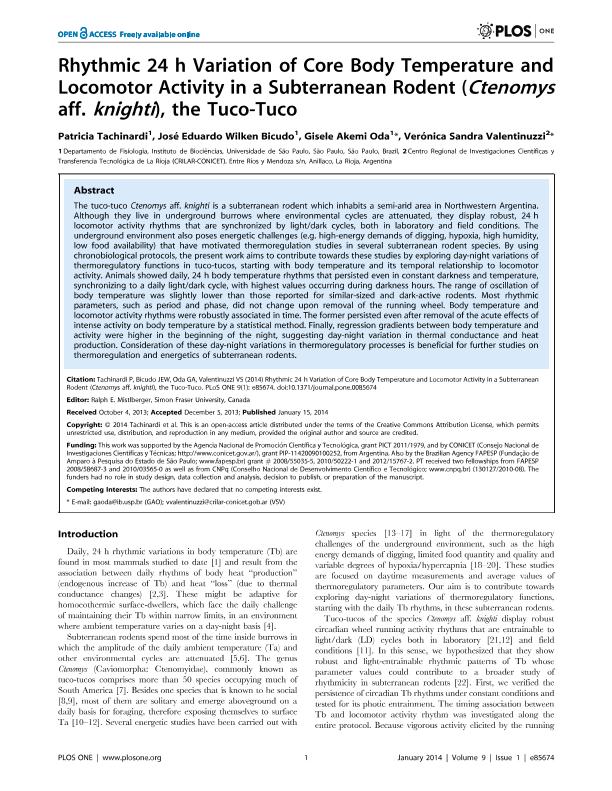Mostrar el registro sencillo del ítem
dc.contributor.author
Tachinardi, Patricia
dc.contributor.author
Bicudo, José Eduardo Willken
dc.contributor.author
Oda, Gisele Akemi
dc.contributor.author
Valentinuzzi, Verónica Sandra

dc.date.available
2017-01-27T20:31:45Z
dc.date.issued
2014-01
dc.identifier.citation
Tachinardi, Patricia; Bicudo, José Eduardo Willken ; Oda, Gisele Akemi; Valentinuzzi, Verónica Sandra; Rhythmic 24 h Variation of Core Body Temperature and Locomotor Activity in a Subterranean Rodent (Ctenomys aff. knighti), the Tuco-Tuco; Public Library Of Science; Plos One; 9; 1; 1-2014; 1-8
dc.identifier.issn
1932-6203
dc.identifier.uri
http://hdl.handle.net/11336/12112
dc.description.abstract
The tuco-tuco Ctenomys aff. knighti is a subterranean rodent which inhabits a semi-arid area in Northwestern Argentina. Although they live in underground burrows where environmental cycles are attenuated, they display robust, 24 h locomotor activity rhythms that are synchronized by light/dark cycles, both in laboratory and field conditions. The underground environment also poses energetic challenges (e.g. high-energy demands of digging, hypoxia, high humidity, low food availability) that have motivated thermoregulation studies in several subterranean rodent species. By using chronobiological protocols, the present work aims to contribute towards these studies by exploring day-night variations of thermoregulatory functions in tuco-tucos, starting with body temperature and its temporal relationship to locomotor activity. Animals showed daily, 24 h body temperature rhythms that persisted even in constant darkness and temperature, synchronizing to a daily light/dark cycle, with highest values occurring during darkness hours. The range of oscillation of body temperature was slightly lower than those reported for similar-sized and dark-active rodents. Most rhythmic parameters, such as period and phase, did not change upon removal of the running wheel. Body temperature and locomotor activity rhythms were robustly associated in time. The former persisted even after removal of the acute effects of intense activity on body temperature by a statistical method. Finally, regression gradients between body temperature and activity were higher in the beginning of the night, suggesting day-night variation in thermal conductance and heat production. Consideration of these day-night variations in thermoregulatory processes is beneficial for further studies on thermoregulation and energetics of subterranean rodents.
dc.format
application/pdf
dc.language.iso
eng
dc.publisher
Public Library Of Science

dc.rights
info:eu-repo/semantics/openAccess
dc.rights.uri
https://creativecommons.org/licenses/by/2.5/ar/
dc.subject
Core Body Temperature Rhythm
dc.subject
Thermoregulation
dc.subject
Subterranean Rodents
dc.subject
Masking
dc.subject.classification
Biología

dc.subject.classification
Ciencias Biológicas

dc.subject.classification
CIENCIAS NATURALES Y EXACTAS

dc.title
Rhythmic 24 h Variation of Core Body Temperature and Locomotor Activity in a Subterranean Rodent (Ctenomys aff. knighti), the Tuco-Tuco
dc.type
info:eu-repo/semantics/article
dc.type
info:ar-repo/semantics/artículo
dc.type
info:eu-repo/semantics/publishedVersion
dc.date.updated
2017-01-27T13:15:37Z
dc.journal.volume
9
dc.journal.number
1
dc.journal.pagination
1-8
dc.journal.pais
Estados Unidos

dc.journal.ciudad
San Francisco
dc.description.fil
Fil: Tachinardi, Patricia. Universidade de Sao Paulo; Brasil
dc.description.fil
Fil: Bicudo, José Eduardo Willken . Universidade de Sao Paulo; Brasil
dc.description.fil
Fil: Oda, Gisele Akemi. Universidade de Sao Paulo; Brasil
dc.description.fil
Fil: Valentinuzzi, Verónica Sandra. Consejo Nacional de Investigaciones Científicas y Técnicas. Centro Regional de Investigaciones Cientificas y Transferencia Tecnológica de Anillaco; Argentina
dc.journal.title
Plos One

dc.relation.alternativeid
info:eu-repo/semantics/altIdentifier/url/http://journals.plos.org/plosone/article?id=10.1371/journal.pone.0085674
dc.relation.alternativeid
info:eu-repo/semantics/altIdentifier/doi/http://dx.doi.org/10.1371/journal.pone.0085674
Archivos asociados
